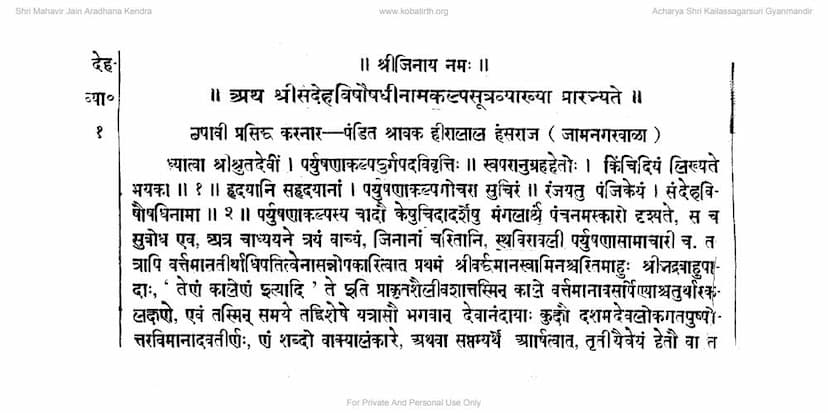Sandeh Vishaushadhi Nam Kalpsutra Vyakhya
Added to library: September 2, 2025

Summary
This document is a commentary, or vyakhya, on the Kalpasutra, a foundational Jain text, titled "Sandeh Vishaushadhi" (Remedy for Doubts). The commentary is authored by Shravak Hiralal Hansraj of Jamnagar.
The text provides an in-depth explanation of the Kalpasutra, which details the life and teachings of Lord Mahavir, the twenty-fourth Jain Tirthankara. The commentary focuses on the auspicious events in Lord Mahavir's life, known as the "Panch Kalyanaka" (five auspicious events) – conception, birth, renunciation, omniscience, and liberation.
Here's a breakdown of the key themes and content from the provided pages:
- Praise for the Author and Text: The commentary begins with invocations and praises for the author, Shravak Hiralal Hansraj, and the text itself, expressing a hope that it will enlighten and benefit readers.
- Explanation of Lord Mahavir's Life: The text meticulously explains the circumstances of Lord Mahavir's descent from the heavens, his birth to Queen Trishala and King Siddhartha, and the auspicious dreams experienced by his mother.
- Detailed Description of Dreams: A significant portion of the commentary is dedicated to interpreting the various dreams of Queen Trishala, including:
- The Lion (Simha): Symbolizing strength, courage, and leadership.
- The Elephant (Gaja): Representing purity, power, and royal status.
- The Bull (Vrishabha): Signifying dharma, fertility, and spiritual strength.
- The Moon (Chandra): Indicating serenity, coolness, and widespread influence.
- The Sun (Surya): Symbolizing divine light, knowledge, and the dispelling of darkness.
- The Flag (Dhvaja): Representing victory and dominion.
- The Jewel (Ratna): Symbolizing divine treasures and purity.
- The Lotus (Kamala): Representing spiritual growth, purity, and liberation.
- The Ocean (Sagar): Signifying vastness, depth, and knowledge.
- The Lion Throne (Simhasana): Representing supreme authority and spiritual power.
- Other auspicious symbols like flowers, divine vessels, and celestial beings.
- Interpretation of Omens and Signs: The commentary also delves into the interpretation of various omens and signs observed by Queen Trishala, relating them to the future greatness of Lord Mahavir.
- Significance of the Panch Kalyanaka: The text emphasizes the profound spiritual significance of these five events, which mark the journey of a Tirthankara towards liberation and the establishment of the Jain path.
- Detailed Explanation of Terms and Concepts: The commentary provides detailed explanations of Jain terminology, rituals, philosophical concepts, and the astrological and astronomical references found in the Kalpasutra.
- Commentary on Rituals and Practices: It discusses various aspects of Jain practice, including asceticism, vows, diet, and the daily routines of monks and nuns, especially during the Paryushana period.
- Genealogy and Lineage: The text touches upon the lineage of the Tirthankaras, providing insights into their ancestry and the spiritual traditions they represent.
- Disciple and Spiritual Hierarchy: It also mentions important disciples and spiritual leaders, such as Gautam Swami, and discusses the role of ganadharas (chief disciples) and the structure of the Jain monastic order.
- Emphasis on Right Conduct and Knowledge: Throughout the commentary, there is a strong emphasis on the importance of right conduct (achara), right knowledge (jnana), and right faith (darshana) as the path to spiritual liberation.
- Linguistic and Grammatical Analysis: The author, Shravak Hiralal Hansraj, engages in detailed linguistic and grammatical analysis of the Prakrit text, explaining the nuances of the language and offering multiple interpretations where necessary.
- Resolution of Doubts: True to its title, the commentary aims to resolve doubts and clarify complex points within the Kalpasutra, making it accessible to a wider audience.
In essence, "Sandeh Vishaushadhi Nam Kalpsutra Vyakhya" is a scholarly and devotional work that aims to illuminate the life and teachings of Lord Mahavir and the core principles of Jainism, drawing from a deep understanding of the scripture and Jain tradition. The commentary is characterized by its detailed explanations, scholarly rigor, and devotional tone.